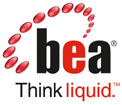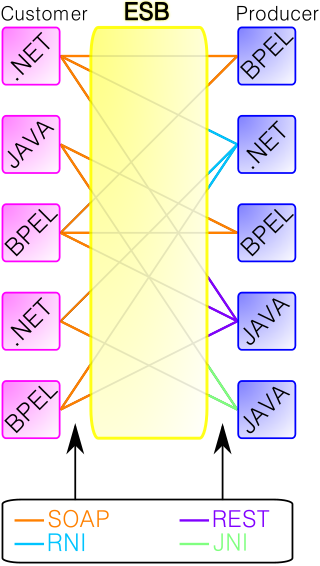Related Research Articles
Middleware in the context of distributed applications is software that provides services beyond those provided by the operating system to enable the various components of a distributed system to communicate and manage data. Middleware supports and simplifies complex distributed applications. It includes web servers, application servers, messaging and similar tools that support application development and delivery. Middleware is especially integral to modern information technology based on XML, SOAP, Web services, and service-oriented architecture.

BEA Systems, Inc. was a company that specialized in enterprise infrastructure software products, which was wholly acquired by Oracle Corporation on April 29, 2008.
Software AG is a German multinational software corporation that develops enterprise software for business process management, integration, and big data analytics. Founded in 1969, the company is headquartered in Darmstadt, Germany, and has offices worldwide.
In software engineering, service-oriented architecture (SOA) is an architectural style that focuses on discrete services instead of a monolithic design. By consequence, it is also applied in the field of software design where services are provided to the other components by application components, through a communication protocol over a network. A service is a discrete unit of functionality that can be accessed remotely and acted upon and updated independently, such as retrieving a credit card statement online. SOA is also intended to be independent of vendors, products and technologies.

An enterprise service bus (ESB) implements a communication system between mutually interacting software applications in a service-oriented architecture (SOA). It represents a software architecture for distributed computing, and is a special variant of the more general client-server model, wherein any application may behave as server or client. ESB promotes agility and flexibility with regard to high-level protocol communication between applications. Its primary use is in enterprise application integration (EAI) of heterogeneous and complex service landscapes.
In computing and systems design, a loosely coupled system is one
- in which components are weakly associated with each other, and thus changes in one component least affect existence or performance of another component.
- in which each of its components has, or makes use of, little or no knowledge of the definitions of other separate components. Subareas include the coupling of classes, interfaces, data, and services. Loose coupling is the opposite of tight coupling.
A business rules engine is a software system that executes one or more business rules in a runtime production environment. The rules might come from legal regulation, company policy, or other sources. A business rule system enables these company policies and other operational decisions to be defined, tested, executed and maintained separately from application code.
A mashup, in web development, is a web page or web application that uses content from more than one source to create a single new service displayed in a single graphical interface. For example, a user could combine the addresses and photographs of their library branches with a Google map to create a map mashup. The term implies easy, fast integration, frequently using open application programming interfaces and data sources to produce enriched results that were not necessarily the original reason for producing the raw source data. The term mashup originally comes from creating something by combining elements from two or more sources.
Java Business Integration (JBI) is a specification developed under the Java Community Process (JCP) for an approach to implementing a service-oriented architecture (SOA). The JCP reference is JSR 208 for JBI 1.0 and JSR 312 for JBI 2.0. JSR 312 was removed from the JCP balloting process on 17 Dec, 2010 by the submitters without being accepted.
A service delivery platform (SDP) is a set of components that provides a service(s) delivery architecture for a type of service delivered to consumer, whether it be a customer or other system. Although it is commonly used in the context of telecommunications, it can apply to any system that provides a service. Although the TM Forum (TMF) is working on defining specifications in this area, there is no standard definition of SDP in industry and different players define its components, breadth, and depth in slightly different ways.
Mule is a lightweight enterprise service bus (ESB) and integration framework provided by MuleSoft. The platform is Java-based but, can broker interactions between other platforms such as .NET using web services or sockets.
Event-driven architecture (EDA) is a software architecture paradigm promoting the production, detection, consumption of, and reaction to events.
IBM App Connect Enterprise is IBM's premier integration software offering, allowing business information to flow between disparate applications across multiple hardware and software platforms. Rules can be applied to the data flowing through user-authored integrations to route and transform the information. The product can be used as an Enterprise Service Bus supplying a communication channel between applications and services in a service-oriented architecture.
OpenESB is a Java-based open-source enterprise service bus. It can be used as a platform for both enterprise application integration and service-oriented architecture. OpenESB allows developers to integrate legacy systems, external and internal partners and new development in business processes. It supports a multitude of integration technologies including standard JBI, XML with support for XML Schemas, WSDL, and BPEL with the aim of simplicity, efficiency, long-term durability, and low TCO.
Service-oriented architectures (SOA) are based on the notion of software services, which are high-level software components that include web services. Implementation of an SOA requires tools as well as run-time infrastructure software. This is collectively referred to as a service-oriented architecture implementation framework or (SOAIF). The SOAIF envisions a comprehensive framework that provides all the technology that an enterprise might need to build and run an SOA. An SOAIF includes both design-time and run-time capabilities as well as all the software functionality an enterprise needs to build and operate an SOA, including service-oriented:
Oracle Enterprise Service Bus, a fundamental component of Oracle's Services-Oriented Architecture suite of products, provides integration of data and enterprise applications within an organisation and their connected enterprises.
Java Composite Application Platform Suite (Java CAPS) is a standards-based enterprise service bus software suite from Oracle Corporation. The suite has several components that help to integrate existing applications and deliver new business services in a service-oriented architecture environment. It is a Java EE compliant platform and provides application-to-application integration, business-to-business integration, business process management along with integrated human workflow, an Enterprise Information Portal, extract transform and load (ETL), business activity monitoring and composite application development.
Middleware analysts are computer software engineers with a specialization in products that connect two different computer systems together. These products can be open-source or proprietary. As the term implies, the software, tools, and technologies used by Middleware analysts sit "in-the-middle", between two or more systems; the purpose being to enable two systems to communicate and share information.
The JBoss Enterprise SOA Platform is free software/open-source Java EE-based service-oriented architecture (SOA) software. The JBoss Enterprise SOA Platform is part of the JBoss Enterprise Middleware portfolio of software. The JBoss Enterprise SOA Platform enables enterprises to integrate services, handle business events, and automate business processes, linking IT resources, data, services and applications. Because it is Java-based, the JBoss application server operates cross-platform: usable on any operating system that supports Java. The JBoss SOA Platform was developed by JBoss, now a division of Red Hat.
Business-oriented architecture is an enterprise architecture approach for designing and implementing strategically aligned business models.
References
- ↑ "Make way for SOA 2.0". 17 May 2006.
- ↑ http://silk.semwebcentral.org/gui-ruleml-2010.pdf Archived 2013-05-21 at the Wayback Machine Causal Vector Engine GUI as Eclipse plug-in.
- ↑ "E. Curry, D. Chambers, and G. Lyons, "Extending Message-Oriented Middleware using Interception", presented at Third International Workshop on Distributed Event-Based Systems (DEBS '04), ICSE '04, Edinburgh, Scotland, UK, 2004" (PDF). Archived from the original (PDF) on 2011-07-26. Retrieved 2011-08-09.
- ↑ http://bicep.dei.uc.pt/images/5/58/FINCoS_DEBS2008.pdf Causal Vector Engine design.
- ↑ http://people.cis.ksu.edu/~bbp9857/bbp_hicss05.pdf Causal Vector Engine algorithmic toolkit.
- ↑ http://people.cis.ksu.edu/~bbp9857/bbp_hicss05.pdf Causal Vector Engine medical domain logic.
- ↑ Zang, ZX; Yan, CG; Dong, ZY; Huang, J; Zang, YF (2012). "Granger causality analysis implementation on MATLAB: a graphic user interface toolkit for fMRI data processing". J. Neurosci. Methods. 203 (2): 418–26. doi:10.1016/j.jneumeth.2011.10.006. PMID 22020117. S2CID 44845757.
- ↑ http://docs.oracle.com/cd/E18727_01/doc.121/e05136/T485796T488110.htm Oracle Business Intelligence engine makes extensive use of temporal data in historical and future time buckets.